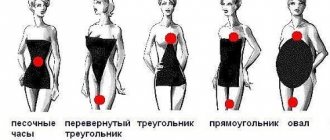The plank is a universal static exercise that allows you to literally develop endurance, strengthen muscles, tighten your stomach and get rid of a couple of extra centimeters in just 30 days.
Rave reviews and photos before and after classes confirm this. The plank works all large muscle groups, including the abs; no additional equipment is required for practice, and the results will not be long in coming, even if you do not combine static loads with other sports.
In this article, we find out why exercise should become the basis of home workouts, what types there are, and draw up a schedule for the first month of classes.
Content:
- What and how the plank trains: before and after photos
- Classic plank - rules of execution
- 30 Day Exercise Plan for Men and Women
- Side plank
- Reverse plank
- Plank with limb extension
- Reviews about the effectiveness of the exercise
What and how the plank trains: photos before and after classes
If performed regularly, this seemingly simple exercise will help you lose weight, pump up your stomach, stimulate the burning of internal fat, give relief to your arms and legs, train your back and, of course, speed up the appearance of the desired six-pack abs.
Get ready that after the first short approaches of 20-30 seconds, all your muscles will ache - this is great, and it means you are on the path to success.
The results of monthly training are clearly visible in the before and after photos.
The plank works with our body in the following directions:
- Exercise strengthens the spine and back; makes pain less pronounced in scoliosis, osteochondrosis and radiculitis.
- Engages the thigh and calf muscles, restoring their elasticity and beautiful expressive shapes.
- Develops strength in the palms, forearms and shoulder girdle as a whole. After three to four weeks, your hands will stop shaking during workouts, and you will feel more confident.
- Your buttocks will acquire a toned, round shape, and there will be significantly less cellulite and stretch marks.
- The abs will be tightened and strengthened.
- Fat will disappear from the waist area, the figure will become slimmer and more harmonious.
- This load has a positive effect on the functioning of the cardiovascular system.
- It prevents joint diseases.
- Increases overall flexibility and endurance.
- Improves mood and fights depression - any physical exercise performed by a person to the limit of his capabilities is better than any therapy or medication in dealing with bad mood and stress.
Of course, such results cannot be achieved in a month with just one plank.
Photos before and after: there are no age restrictions for exercise if you feel well
Photos before and after: along with your appearance, your mood also changes.
The exercise also works the rectus and oblique abdominal muscles, the transverse muscle, the gluteal muscles, the rectus abdominis and the proximal femoris.
At the same time, the bar is one of the least traumatic types of training and can be contraindicated only in the following cases:
- In the postpartum period, after cesarean section, with diastasis of the abdominal muscles
- After recent operations
- For high blood pressure
- Hernia and serious joint pathologies
- In case of exacerbation of chronic diseases
Tip: Scientists at Columbia University have proven that regularly performing side planks reduces pain in osteochondrosis by almost 40%.
Now let’s figure out what types of planks there are, how to perform the exercise correctly, calculate a training plan for 30 days and see how body proportions change before and after regular exercises with photographs and reviews of practitioners of the technique.
Print daily planner template
You can start learning how to plan with your daily schedule. Try making a to-do list broken down by hour for tomorrow: to do this, write down all your tasks for tomorrow, and then enter it for the appropriate hour with the necessary notes.
So, you will have a full-fledged daily diary in A4 size. It does not take up much space in your bag, and always helps you navigate meetings and other matters in just a couple of seconds.
This is what a daily planner template looks like:
A stylish and minimalistic template suitable for all planning beginners. To work with this planner, we recommend using the Pomodoro time management technique: alternate 25- and 5-minute periods of time, allocating 25 for work and 5 for rest. After four such alternations, you need to take a long break of 10 minutes. For more information about the technique, watch the video below:
Want this printable template? Click on the “Download template” button:
Classic plank - rules of execution
Basic version of the exercise. It is recommended to start training with it.
Traditional technique
How to do it: lie on your stomach, raise your upper body and stand on your elbows, then on your toes, pointing them towards you.
Place your arms bent at the elbows at an angle of 90 degrees. The head is raised, the gaze is directed forward.
The abdominal muscles are tense, the body is elongated in an even line without sagging. The back is not hunched. We start with three approaches of thirty seconds.
For a beginner, one and a half minutes at first may seem like a real test, which, however, will become easier day by day.
If things are not going well, simplify the task in the first two weeks:
- Perform the lighter version with arms outstretched.
- Spread your legs wider, this will reduce the load; accordingly, if you put your feet next to each other, the task will become more difficult
- Do more sets in less time; the ideal rest time between them should not exceed a minute
When the basic technique completely submits to you, move on to more complicated options and start rocking your pelvis - this way the load will be maximum.
Plank exercise plan for 30 days for men and women, before and after photos
This training plan is suitable for both men and women.
As you can see from the table above, after a month of active training with short breaks, you should increase your endurance from thirty seconds to five minutes.
Of course, you won’t be able to achieve an ideal body in a month with just one plank, but in combination with an elementary diet and other types of physical activity, your body will noticeably tighten and become slimmer.
How to learn the multiplication table
In the modern education system, multiplication tables begin to be studied in the 2nd grade, and in some schools already in the 1st grade.
Not all children are equally good at remembering numbers. But it doesn’t matter, the main thing here is perseverance and training. If you regularly study with your child, then any child will be able to learn the table and remember it for life. There is no need to put pressure and force the child, it is better to interest and motivate him. If you can’t just learn it, you can resort to small tricks, in the form of rhymes or various associations.
How to learn the multiplication table
At the very beginning, it is necessary to show the child what multiplication is so that he understands the meaning. It is necessary to explain that multiplication is the same as addition, only written in a shorter, easier-to-understand form. Show an example of 2x2 or 2x3 first, and then a longer version like 2x8. We need to show that 2x8 is the same as 2+2+2+2+2+2+2+2 or 8+8. Having understood this, it will be much easier for the child to memorize the table.
It is best to start learning the multiplication table with the first three columns, as they are easier to remember. Having understood the meaning of the tables, the child often chooses the easiest way for him to memorize. Your task is to offer him several ways. It won’t work one way, others will help. All children have different memories; some remember numbers well, while others have better associative memory. Each child needs a different approach. The main thing is patience!
Multiply by 1
Everything is simple here, you need to explain to the kid that when you multiply any number by one (except zero, of course), you get the number that we multiplied. To reinforce the material, invite your child to multiply large numbers by one (one hundred, thousand, and so on).
Multiply by 2
This column is also not difficult to remember. We just need to show that multiplying by 2 is the same thing if we add another exactly the same number to the number we are multiplying.
Multiply by 3
If the child has completed multiplication by 2 well, then for better memorization you can show that multiplication by three is also the addition of three identical numbers.
Side plank - execution technique
This type of load involves additional muscles of the chest, back, arms and legs and is especially effective in combating fat deposits on the sides.
How to do it: lie on your side, raise your torso and lean on your bent elbow. We place the left hand on the thigh.
We tighten our abs and maintain balance, leaning on our forearm and foot. Start doing it for 20-30 seconds, gradually increasing the time. Repeat the exercise on the second side.
Make sure that the body does not sag, the buttocks are tense and fixed in one position. The legs are brought together so as not to increase the load on the joints.
Side plank
If the exercise is difficult, you can make the task easier by leaning on your knee. Make it more difficult by using support on two points.
Take a classic plank position. Raise your free arm and leg up, but do not bend it, but keep it straight.
The schedule is being drawn up in stages.
The accounting period is selected
It is necessary to set the working time recording period - month, quarter, year. The selected time period directly depends on the nature of production, its specifics, and the characteristics of labor.
Example. College employees must complete an hourly workload from September to May. We distribute the hours of workload for the teacher according to the accounting period. In this case, summer is excluded and included in the vacation period. If the earned vacation time is not enough (for example, vacation is 44 days, the teacher is not involved - 90 days), the teacher is offered rest at his own expense, additional workload or other options. The accounting period in this case is the academic year (not the financial year).
The time fund for servicing a specific workplace is calculated
For each workplace, the fund of serviced time is calculated. Loading the workplace. The load for any type of schedule is calculated in hours and minutes.
For example. The workplace of a turner-milling operator functions according to the action of the machine. The machine works for 3 hours non-stop. After three hours, the unit takes 1.5 hours to cool down. Therefore, the operating time of the machine is 15 hours per day. The last rest for the machine is given for 3 hours. During this time, shift changes can be arranged in the work schedule. Men work on these machines - their working hours are 8 hours, so with the right schedule, you can easily assign two staff units to one machine.
If the employee’s place is occupied for 24 hours (power grid manager). This norm is calculated for the accounting period (year) and is evenly distributed over the working time of individual employees.
The hourly rate is determined
The duration of work of individual specialties has a different meaning from that of the entire staff. The schedule assigns a value to each employee if his standard working time differs from the standard of work of others.
Example. Various specialists work in an educational institution. The length of their working week is different, for example, a teacher is required to work 36 hours a week, a music director - 24 hours, a teacher - speech therapist - 20 hours. The maximum operating time per month (production rate) is different for them, it should be reflected in the schedule. The load should not be allowed to exceed the norm, as it will require additional financial investments.
Counting the number of workers
The number of employees per workplace and the total number of staff are calculated. This number of employees must serve the workplace and fulfill the plan. This results in a quantitative staffing structure – staff. Standard indicator of staffing units of an enterprise.
Example. The duty dispatcher of the power grid organizes round-the-clock duty at the control panel. The accounting period of its work is calculated for the financial year. The total service time for the dispatcher's workplace is 8760 hours (365 calendar days × 24 hours). We calculate the number required to service this workplace; it is approximately 4.8 people. In practice, an employer can hire five people, or maybe four, distributing part-time wages among employees.
A schedule is being formed
Job positions are entered into the selected form, then data is filled in for the specialists serving the jobs, and the hourly rate is distributed between them. A production is exhibited that includes all the individual features of each workplace. Weekends and holidays are included. The principle of filling is the principle of uniformity, distribution in approximately equal volumes between specialists.
The number of shifts is calculated and the shifts between employees are recorded.
The main task of creating a schedule is accessibility when perceived by the employee, and simplicity and legibility for calculation by the accounting department. All full-time employees of the enterprise are included in the schedule. The schedule requires daily adjustments (sick leave, business trips, time off). If the basic data is entered in advance, this process is easier than entering data every day.
- Salary. The work schedule is the basis for remuneration; it is transferred to the working time sheet and the employee’s wages are calculated. Therefore, it is important to make a schedule in such a way that there is no possibility of erroneous calculations.
- Payment for overtime is based on payment for hours worked by the employee in excess of the norm. Only correct data entered into the chart will give accurate recycling figures.
- Pay for night work. Night work time is considered to be the period from 22:00 to 6:00. In the schedule, night hours are recorded and counted in a separate column. Their pay is higher than regular hours, 35% of the basic salary, in addition to wages for hours worked. The employer, taking into account the complexity of night work, can establish other increased payment indicators.
Reverse plank - execution technique
This variation is similar to the classic position, but done in reverse: your body resembles a coffee table. The reverse plank is especially recommended for people with back pain. In this technique, the time that you stand is not so important as the correctness of all actions.
Reverse plank
How to do it: sit on the floor and straighten your legs. Place your palms on the floor and spread your fingers to distribute the load evenly.
We tilt the torso back to the floor at an angle of 45 degrees. We place our hands behind the buttocks in line with the shoulders. Raise your torso, legs and butt until they are extended in a straight line. We tense our abdominal muscles.
We start with 20 seconds and increase the time. Slowly return to the starting position.
Tip: If you feel your hips starting to sink, stop and do another set after a minute.
The most common mistakes when performing a reverse plank are the head thrown back/chin pressed to the chest/non-compliance with the geometry of the exercise.
When the load goes into the hands, the remaining muscles stop working at full strength.
With limb extension
Plank with limb extension
We make our task as difficult as possible.
How to do it: get into a classic plank position. Extend your arm forward parallel to the floor. We start with thirty seconds.
We return to the starting position. Then we repeat the same thing, but with the leg raised. We perform the technique for the other arm and leg.
You can complicate the task if, together with extending your arm or leg, you make various movements in the air, alternately pulling the knee of the same name towards your arm, turning your head to the sides for better body work.
Tip: While in any type of plank, keep your abdominal, arm and leg muscles tense. This distributes the weight evenly and reduces the strain on your back.
Knee Pull Variation
Reviews about the effectiveness of the exercise
The figure below shows variations of the plank and a diagram of the exercise, designed for 30 days.
As with any load, the main thing here is systematicity. And within a month you will be able to see the difference “before” and “after” by looking at your own photographs. You can find a lot of positive reviews online.
Comprehensive training plan for a month
Download checklist for weight loss 30 days
Anyone who wants to lose weight usually faces the problem of self-control. You need to mark your workouts and useful actions somewhere. For such people, I created a 30-day weight loss checklist. You can download it, print it, hang it on your refrigerator and use it.
The basis for this checklist was the daily actions and workouts that I, the author of the blog BACK TO HEALTH, Tatyana Kuzmenko, do.
You can download the checklist for losing weight for 30 days at the end of the article. But before that, be sure to read the article, it contains the necessary explanations.
You may be surprised by the fact that the checklist includes items related not only to training, but also to drinking water. You may ask, what does water have to do with it?
Why does the 30-day weight loss checklist contain an item about water?
I have already written about why it is important for health to drink 1.5-2 liters of water a day. Healthy lifestyle and weight loss are very connected. We can say that losing weight is a side effect of a healthy lifestyle.











